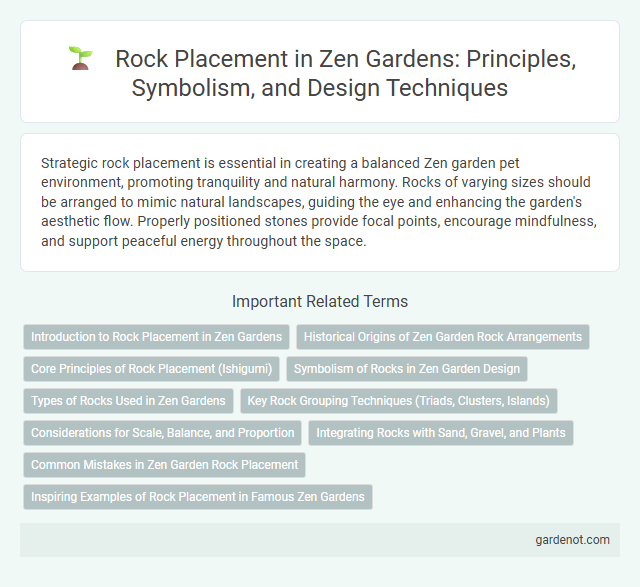Strategic rock placement is essential in creating a balanced Zen garden pet environment, promoting tranquility and natural harmony. Rocks of varying sizes should be arranged to mimic natural landscapes, guiding the eye and enhancing the garden's aesthetic flow. Properly positioned stones provide focal points, encourage mindfulness, and support peaceful energy throughout the space.
Introduction to Rock Placement in Zen Gardens
Rock placement in Zen gardens is a fundamental practice that embodies principles of balance, harmony, and natural beauty. Carefully positioned rocks represent mountains, islands, or animals, creating a symbolic landscape that invites contemplation and tranquility. The arrangement emphasizes asymmetry and negative space to evoke a sense of depth and timelessness within a minimalist design.
Historical Origins of Zen Garden Rock Arrangements
Zen garden rock placement originates from ancient Japanese landscaping traditions rooted in Zen Buddhism, emphasizing simplicity, natural beauty, and symbolic representation of mountains or islands. Historical texts and temple anecdotes reveal that rocks were meticulously positioned to evoke spiritual contemplation and balance, reflecting Zen principles of harmony and tranquility. The deliberate arrangement draws inspiration from Chinese garden art and evolves through periods like the Muromachi era, highlighting the integration of nature and meditation in garden design.
Core Principles of Rock Placement (Ishigumi)
Rock placement in a Zen garden follows the core principles of Ishigumi, emphasizing balance, asymmetry, and naturalness to evoke tranquility and harmony. Each rock is carefully positioned to represent elements of nature, such as mountains or islands, creating symbolic landscapes that guide the viewer's meditation. Proper arrangement avoids uniform patterns, fostering a dynamic composition that inspires contemplation and spiritual connection.
Symbolism of Rocks in Zen Garden Design
Careful rock placement in Zen gardens symbolizes stability, endurance, and the natural flow of energy, reflecting the principles of Zen Buddhism. Rocks of varying sizes represent mountains, islands, or animals, creating a miniature landscape that encourages meditation and mindfulness. The deliberate arrangement emphasizes balance, harmony, and the connection between the earthly and spiritual realms.
Types of Rocks Used in Zen Gardens
Zen gardens primarily feature three types of rocks: tall, vertical stones symbolizing mountains; flat, horizontal stones representing water or land; and rounded stones embodying islands or animals. These rocks are carefully selected for their texture, color, and shape to create a balanced and harmonious composition. Placement emphasizes natural asymmetry, ensuring each rock contributes to the garden's meditative atmosphere and symbolic meaning.
Key Rock Grouping Techniques (Triads, Clusters, Islands)
Effective rock placement in a Zen garden hinges on three key grouping techniques: triads, clusters, and islands. Triads, composed of three stones, create dynamic balance and visual harmony, often symbolizing the Buddhist trinity or natural elements. Clusters arrange multiple rocks closely together to suggest rugged landscapes or mountain formations, while islands position isolated stones to evoke solitude and meditation focus.
Considerations for Scale, Balance, and Proportion
Rock placement in a Zen garden requires careful consideration of scale, balance, and proportion to create a harmonious and natural aesthetic. Selecting rocks of varying sizes but complementary shapes ensures visual balance while maintaining a sense of natural randomness. Proper spacing and alignment enhance the garden's tranquil atmosphere by mimicking natural landscapes and guiding the viewer's eye through the space effectively.
Integrating Rocks with Sand, Gravel, and Plants
Strategic rock placement in a Zen garden enhances harmony by integrating natural stones with surrounding sand, gravel, and plants. Arranging rocks in asymmetric clusters mimics natural landscapes while guiding visual flow, creating balance between solid and fluid elements. Incorporating rocks with carefully raked sand patterns and sparse foliage emphasizes simplicity and evokes tranquility for meditative spaces.
Common Mistakes in Zen Garden Rock Placement
Common mistakes in Zen garden rock placement include overcrowding rocks, which disrupts the intended harmony and balance, and misaligning them without considering natural flow or symbolism. Placing rocks of similar size and shape can reduce visual interest and fail to evoke the desired sense of tranquility. Proper placement respects principles like asymmetry, space, and the natural landscape to create a contemplative environment.
Inspiring Examples of Rock Placement in Famous Zen Gardens
Famous Zen gardens such as Ryoan-ji in Kyoto feature carefully placed rocks that symbolize mountains and islands, creating a balanced and contemplative space. The strategic positioning of stones in the Adachi Museum garden blends natural forms with minimalist design, enhancing tranquility and visual harmony. These inspiring examples demonstrate how precise rock placement fosters meditation and reflects Zen principles of simplicity and nature.
Rock placement Infographic

 gardenot.com
gardenot.com